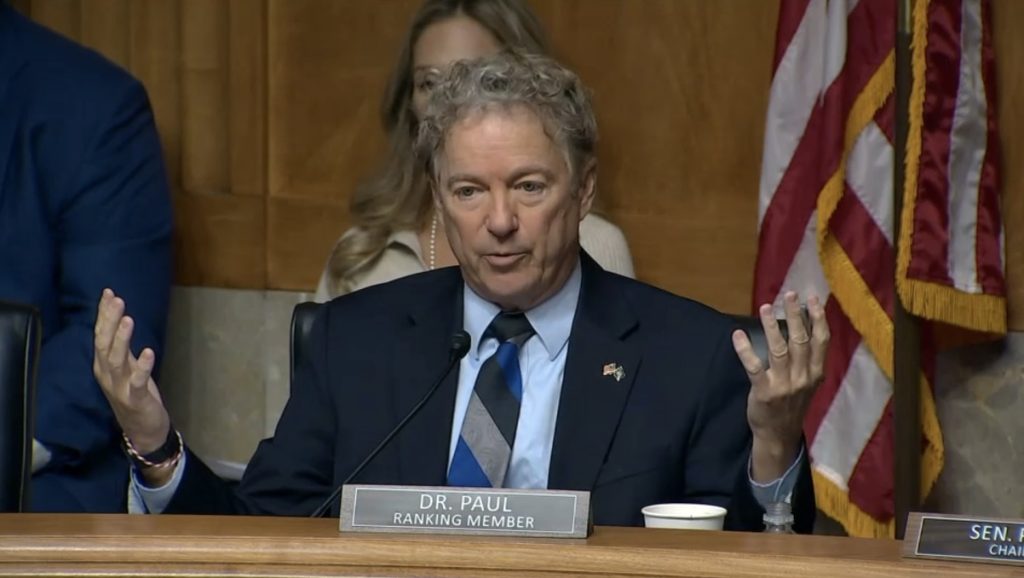WASHINGTON, D.C. – Today, U.S. Senator Rand Paul (R-KY), Ranking Member of the Senate Homeland Security and Governmental Affairs Committee, demanded answers regarding the ongoing financial issues at the United States Postal Service (USPS). During a hearing titled “Oversight of the United States Postal Service: Understanding Proposed Service Changes,” Dr. Paul called on the Postal Service to implement significant structural labor reforms.
Dr. Paul highlighted that despite receiving more than $120 billion since 2020, the Postal Service continues to undergo significant financial losses due to an inefficient labor structure. This year, the Postal Service reported a net loss of $9.5 billion, nearly a 50% increase from last year’s loss of $6.5 billion. However, even with the ongoing financial shortfalls, the Postal Service has converted 190,000 employees to permanent, unionized positions with significant pension and healthcare obligations, contributing to its growing debt. Dr. Paul pointed out that private businesses facing uncontrolled costs and a declining business model would not increase their expensive workforce. Instead, private businesses would handle lingering labor costs by adjusting and making cuts where necessary. Postmaster General DeJoy tried to downplay these issues, but Dr. Paul emphasized the Postal Service’s ongoing financial troubles are irresponsible considering the over $36 trillion debt impacting the American taxpayer. Dr. Paul urged Congress to stop wasting funds on USPS until it balances its budget through alternative labor solutions or outsourcing its workforce.

View the Ranking Member’s opening statement here, and questioning here.
Opening remarks as prepared below:
Over 40 years ago, Milton Friedman remarked, “If you put the federal government in charge of the Sahara Desert, in five years there’d be a shortage of sand.”
While Friedman was discussing price controls and output restrictions on oil and gas production in Dubai, this same logic can be applied to the United States Postal Service. In 2020, Congress was promised that a $107 billion bailout would pull the Postal Service out of the hole it was in within 3 or 4 years. We were also told that USPS operations would break-even by 2031. Postmaster General DeJoy sat in front of this committee in August of that year and stated, “I am absolutely convinced that with some help from Congress and our regulator, we can do it, and that there is a bright future ahead for the Postal Service.” I argued against giving more taxpayer money to the Postal Service, suggesting that private businesses would better manage ongoing costs by making necessary cuts. Unfortunately, my concerns have proven to be correct.
The Postal Service’s Delivering for America (DFA) initiative was expected to yield quick results. However, the Postal Service lost $6.5 billion in Fiscal Year 2023 and things got worse in Fiscal Year 2024 when USPS lost $9.5 billion. It is clear DFA isn’t working.
Given the continued financial shortfalls, it is entirely nonsensical for USPS to convert more than 190,000 Service workers into career roles since October 2020. These career roles, effectively allow those workers to make 50% more hourly and create decades of benefits responsibility that will make breaking even in the future even more difficult. Further these positions are insourcing jobs that were provided at lower cost by private partners. During the Postal Service Reform Act, I argued no funding should be given to USPS without changes to its labor practices. Instead, no labor changes were made and now Americans are left holding the bag of an ever more bloated Postal Service.
The Postal Service has tried to explain away these bad numbers due to “costs that [the USPS] cannot control.” But the Service is spending $9.6 billion in electric delivery vehicles and spending nearly $40 billion over 10 years to convert and build certain facilities into hubs that so far have resulted in worse delivery times and service. In order to keep making these infrastructure updates the Postal Service has asked to raise its $15 billion borrowing limit with the Treasury Department. Private sector companies deal with uncontrolled costs all the time, including the same factors USPS faces like inflation, and they find a way to provide for their owners and shareholders. USPS should account for the “uncontrollable costs” in their budgeting and stop coming to Congress to bail them out.
This hasn’t stopped Congress though from throwing even more money at the Postal Service. For those counting, that’s $120 billion in funding and relief in the past 4 years alone.
While $120 billion is already an astounding number on its own, when you consider this sum relative to our nation’s dismal fiscal condition it suddenly becomes reckless. We are over $36 trillion in debt, or 123 percent of GDP. This is the highest level of debt this nation has ever had, and we show no signs of slowing down adding $1 trillion to our national debt every 100 days. This year, we have already spent more to pay the interest on our debt than we have on our own defense.
Earlier this year, the Postal Service asked Congress to provide it with an additional $14 to $100 billion in taxpayer dollars by transferring funds from the Office of Personnel Management to USPS. At some point Congress needs to pull its head out of the sand and stop throwing money we don’t have to maintain the status quo, especially when status quo means more deficits. USPS needs massive structural reform, not necessarily in its network, but in its workforce hiring and retention.
The hearing today will provide transparency and examine what American dollars are funding and reveal Congress’s lack of prudence in legislative decision making.
###